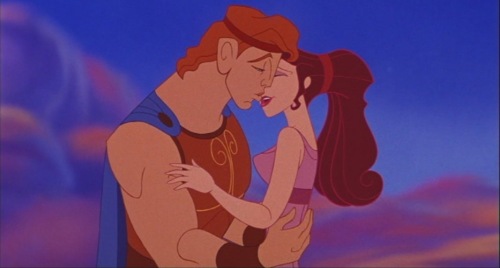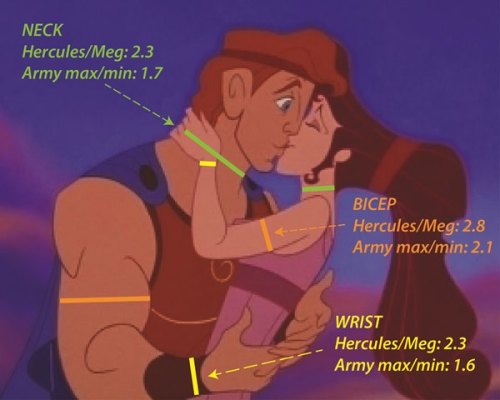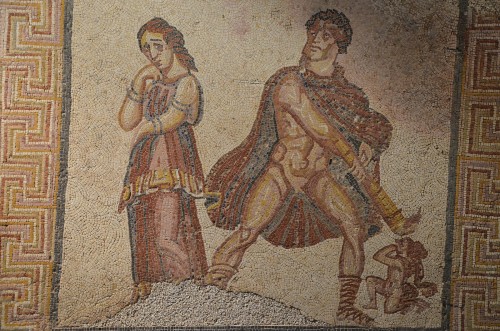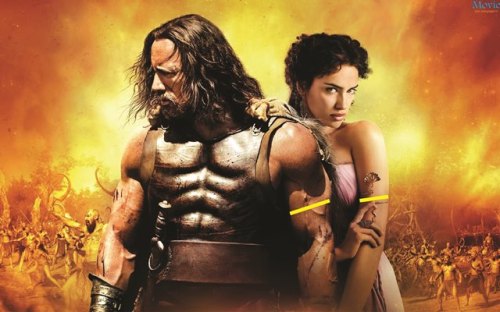I know, I know, Hercules is a demi-god. But he’s also all man. In Disney’s (1997) version, Hades says to Megara, “I need someone who can — handle him as a man.” And handle him she does:
And since they involve him in such matters of the human flesh (and heart), that means their measurements are fair game for the Disney dimorphism series. If Disney is going to eroticize the relationship and sell it to innocent children, then we should ask what they’re selling.
As usual, they’re selling extreme sex dimorphism. I did some simple measurements from one pretty straight shot in the movie, and compared it to this awesome set of measurements taken of about 4,000 U.S. Army men and women in the late 1980s. Since Hercules is obviously extremely strong and this woman seems to be on the petite side, I compared their measurements to those of the biggest man versus the smallest woman on each dimension in the entire Army sample. The numbers shown are the man/woman ratios: Hercules/Meg versus the Army maximum/minimum.
As you can see, this cartoon Hercules is more extremely big compared to his cartoon love interest than even the widest man-woman comparison you can find in the Army sample, by a lot. (Notice his relaxed hands – he’s not flexing that bicep.)
To show how unrealistic this is, we can compare it to images of the actual Hercules. Here’s one from about 1620 (“Hercules slaying the Children of Megara,” by Allessandro Turchi):
That Hercules is appallingly scrawny compared with Disney’s. Here’s another weakling version, from the 3rd or 4th century:
Now here is one from the 2014 Paramount movie, in which he is conveniently paired with the human female, Ergenia:
That bicep ratio is only 1.5-to-1. And that’s not normal.
Seriously, though, isn’t it interesting that both the Disney and the Paramount versions show more extreme dimorphism than the ancient representations? Go ahead, tell me he’s a demigod, that it’s a cartoon, that it’s not supposed to be realistic. I have heard all that before, and responded with counterexamples. But that doesn’t explain why the modern versions of this myth should show more sex dimorphism than the old-school ones. That’s progress of a certain kind.
I’ve written so far about Frozen and Brave, Tangled, and Gnomeo and Juliet, and How to Train Your Dragon 2. It all goes back to the critique, which I first discussed here and Lisa Wade described here, of the idea that male and female humans aren’t just different, they’re opposites. This contributes to the idea that Mark Regnerus defends as the “vision of complementarity” — the insistence that children need a male and female parent — which drives opposition to same-sex marriage. If men and women are too similar, then we wouldn’t need them to be paired up in order to have complete families or sexual relationships.
In the more mundane aspects of relationships — attraction and mate selection — this thinking helps set up the ideal in which women should be smaller than men, the result of which is pairing couples by man-taller-woman-shorter much more than would occur by chance (I reported on this here, but you also could have read about it from 538’s Mona Chalabi 19 months later). The prevalence of such pairs increases the odds that any given couple we (or our children) observe or interact with will include a man who is taller and stronger than his partner. This is also behind some notions that men and women should work in different — and unequal — occupations. And so on.
So I’m not letting this go.
Philip N. Cohen is a professor of sociology at the University of Maryland, College Park. He is the author of The Family: Diversity, Inequality, and Social Change and writes the blog Family Inequality, where this post originally appeared. You can follow him on Twitter or Facebook.






Comments 49
Umlud — January 6, 2015
While I agree with your premise and our conclusions, there are two points in your assessment that are troubling to me.
First is a point about the methodology:
You are comparing the ratio of the maximum male measurements vs the minimum female measurements from US Army data. However, is this an appropriate dataset against which to compare Hercules (who was a demigod renown for his strength; not a modern soldier) and Megara (who was a literal princess; not a modern soldier)? Wouldn't a more appropriate set for comparison for Hercules be male bodybuilders, weightlifters, or even professional wrestlers (who embody different modern-day social concepts of masculine strength)? In comparison, wouldn't a better comparison for Megara be taken from upper-SES women?
I understand that this is somewhat of a back-of-the-envelope calculation, but my point is that I don't really think that the basis for comparison is really justified, based on your explanation. (Although I do agree that it's a really awesome set of measurements.)
As an additional point here, one could argue that the measurements from the movie poster aren't really appropriate, since the angle of the arm of Dwayne Johnson (who played Hercules) is at a more oblique angle than Irina Shayk's (who played Megara), making the resulting ratio smaller than it would likely be if both arms were actually measured straight-on. (Although I'm almost certain that the ratio would be far smaller than the comparative ratio depicted in the Disney cartoon.)
The next is more of a point about semantics:
The grammatical fault (that the above is composed of two fragments) aside, are you saying that Hercules was an actual person?
Charles Richter — January 6, 2015
Wait--images of the "actual Hercules?"
Benjamin Bias — January 6, 2015
Eight time Mr Olympia Ronnie Coleman has a bicep measurement of 24 inches. Ten time Ms Olympia Iris Kyle has a bicep measurement of 17 inches. Ratio 1.4.
To get a ratio of 2.4 vs Mr Olympia would require the woman to have an upper arm circumference of 10 inches. Is that impossible for a waif skinny model?
Herculean Dimorphism - Treat Them Better — January 6, 2015
[…] Herculean Dimorphism […]
Looking for thought-provoking images/items for discussions and activities? | Skills-Based Health Education — January 6, 2015
[…] would fall under the “Analyzing Influences” skill. For example their most recent post, Herculean Dimorphism, discusses how modern versions of the Hercules myth show more dimorphism than ancient depictions […]
Steve — January 6, 2015
" (Notice his relaxed hands – he’s not flexing that bicep.)"
Flexing the bicep can be performed by supination of the forearm. It's quite easy to do without tightening your hand. Try holding out your hand like you're being given a cup of soup.
Cory Dorsey — January 7, 2015
This is right up there with "Video games cause school shootings".
Quartz Daily Brief—Americas edition—AirAsia tail found, US pipeline politics, Monster sues Beats, sunblocked grapes – Quartz — January 7, 2015
[…] should stop featuring massive men and skinny women. Its “extreme sex dimorphism” is hurting […]
Simon Fodden — January 7, 2015
Two "biceps", one "biceps". Don't make it smaller than it should be.
HowardBrazee — January 7, 2015
I suppose gods and goddesses can look however they wish to look. Hollywood thinks Jehovah wants to look like an old man. Why?
I always wondered why Superman has lots of muscles. Lifting weights didn't do it. He wasn't less strong as Superboy or Superbaby without those muscles. Maybe he does isometrics out of vanity.
jlm656 — January 7, 2015
I can agree with your position that men and women should be treated equitably - equal work for equal pay, women should not be subjected to abuse by men, etc. However, men and women *are* different. We have evolved to be different; our differences matter, and cannot be swept aside to serve transient social concerns such as your current indignation over the persistence of the traditional family, an institution that goes hand in hand with our human evolutionary story.
To me, you analysis all adds up to 'so what?'. Disney makes cartoons; cartoons have always and everywhere presented their audiences with caricatures - there is no news there. Do cartoon character tend to reinforce traditional idealized views of men and women? Why, yes, they do. Is it anything to get all upset about? No. Disney did not create these stereotypes, human culture did - Disney is just playing to these archetypes for profit, and bully for them. Gender relations need to be improved in this country, but attacking Disney is hardly the best starting point.
George Soros — January 7, 2015
The Rock paired with Gisele would make for odd size comparisons.
Sal Volatile — January 7, 2015
"To show how unrealistic this is, we can compare it to images of the actual Hercules."
Really? You are going to show us how unrealistic something is that is unreal to begin with? There are no images of the actual Hercules any more than there are images of an actual unicorn.
"But that doesn’t explain why the modern versions of this myth should show more sex dimorphism than the old-school ones."
Did the ancients have access to the physiological/nutritional science, personal trainers, and chemical means to drastically augment their physiques that we have access to today? Did the ancients have the time to spend eight hours a day in the gym training? You are comparing apples to oranges here.
Men, in general, are bigger and stronger than women. Men today who train their physiques are bigger and stronger than men of yesteryear. Take a look at bodybuilders from say, the 1940s, and compare them with those today. It is no wonder, then, as to why there is such extreme dimorphism seen today in pop culture; it is art imitating life.
S363 — January 7, 2015
While you're critiquing cartoons for their lack of adherence to reality, take note that in the Roadrunner cartoons Wile E Coyote repeatedly survives being crushed by an anvil. This is inaccurate. Coyotes can't actually survive being crushed by anvils.
Quartz Daily Brief—Americas edition—AirAsia tail found, US pipeline politics, Monster sues Beats, sunblocked grapes | 3Buzz Now — January 7, 2015
[…] should stop featuring massive men and skinny women. Its “extreme sex dimorphism” is hurting […]
cptnbreakdance — January 7, 2015
Why stop there? Why not measure ratio of Danny Devito's Philoctetes' legs to that of the modern goat? Don't you think that is a more "extreme" case of dimorphism? There are much better things to argue and philosophize about dude.
David Phillips — January 7, 2015
dimorphism in name also. you truncated megara's.
crackerme_crackermenot — January 7, 2015
"If men and women are too similar, then we wouldn’t need them to be
paired up in order to have complete families or sexual relationships"
Umm, you mean besides the biological imperative of sexual intercourse for procreation? Why is this glaring departure from reality not evidence of your own extreme agenda? See how easy it is is to extrapolate bad motive from other's choices?
The things which are — January 8, 2015
Cartoons use a style with vastly exaggerated features. If you really want to go into the anatomy, then Hercules's hair is a freaking tentacle resembling hair on his head.
In terms of social balance its still accurate. Overly fit men go for overly fit women. Tall people look for shorter partners so that their offspring would be of the acceptable social middle norm. If these two were to have offspring, then the kid would be average.
The world is as it is, whether you like it or not. Disney should not apologize for displaying the world that way and make it "cartoony" for kids. As it is their perspective - you don't need to agree with it or even like it.
What are you pressing for here? Attention?
Víkendové surfovanie « life in progress — January 10, 2015
[…] Herculean dimorphism […]
Year-end report | Family Inequality — December 28, 2015
[…] Herculean dimorphism. Thanks in part to a hefty repost on Sociological Images, this turned out to be one of the most popular in my series on sex […]
K — July 26, 2021
This guy needs a better hobby.
gator — July 11, 2022
Damn, cartoons aren't realistic? That's fuckin crazy bro.
gator — July 11, 2022
Also, children do need a male and female parent. Cope and seethe, degenerate.